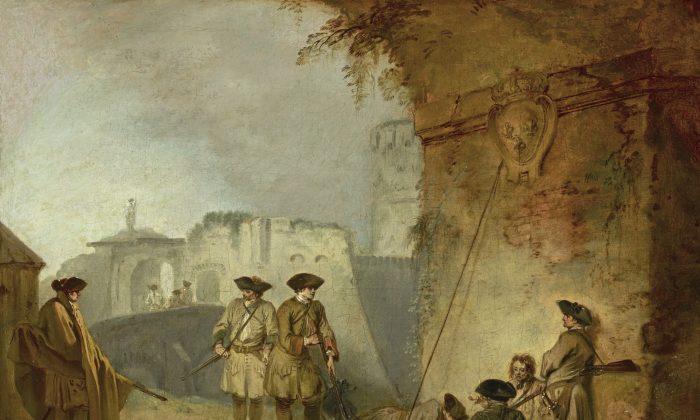NEW YORK—Andrea del Sarto (1486–1530) is not an unknown artist, but despite being a leading Renaissance artist he has been overshadowed during subsequent centuries by his contemporaries: Leonardo da Vinci, Michelangelo, and Raphael.
The current exhibition Andrea del Sarto: The Renaissance Workshop in Action, organized by The Frick Collection and the J. Paul Getty Museum is showing a selection of nearly 50 drawings and three related paintings revealing the artist’s creative process and his progression from one medium to another.
Why del Sarto went out of favor despite running the most successful workshop in Florence is still unknown.
Some scholars have pointed to the negative biography in “Lives of the Artists” written by del Sarto’s own pupil—Giorgio Vasari (1511–1574) as partly to blame for the artist’s decline in popularity. In it Vasari criticizes del Sarto for using his wife as a subject all too often and being overly controlled by her, writing, “He never put a woman in any picture, which he did not draw from her.”
Vasari ties this with the idea that had it not been for his wife, del Sarto would have surpassed Raphael in his accomplishments. The common practice of the time was to use male models even in studies for female depictions.
This point served as inspiration for 19th century English poet Robert Browning’s work called “Andrea del Sarto”—a long, dramatic, monologue in which the artist laments his inner contradictions and insecurities as outlined in Vasari’s biography. Unfortunately, most students’ introduction to del Sarto is through Browning’s poem found in high school English textbooks.
However, according to exhibition associate curator Aimee Ng, modern scholars who have recently looked at Vasari’s biography and studied the archives have come to the conclusion that, in fact, what Vasari wrote was not true. “[His wife] was not the fall of del Sarto, yet Vasari’s version persisted,” said Ng.
Paradoxically, in the same biography where Vasari creates such a negative image of del Sarto, he admits that the del Sarto’s figures are faultless.
Coming face to face with del Sarto’s works finally vindicates the artist and cuts through all the flourishes of negative “propaganda” and perhaps an overstretch of poetic license, in Browning’s case, due to the direct expressive force of his works. There is an intimacy and a spiritual probing that is revealed in the gaze of his subjects in a way that only great artists can achieve.
In his “Study of the Head of a Young Woman,” which was a study of Mary Magdalene, del Sarto captures the introverted, and somewhat distant gaze of the woman, and beside the drawing, a faint reworking of her hair to get it just right, given that she used her hair to dry the feet of Jesus.
Some of the drawings in the exhibition are so refined that they can be considered finished paintings. Del Sarto fully exploited the tonal rage of red chalk by also wetting the parts of a drawing with a brush to dissolve the pigment and rub it to achieve breathtaking textural effects.
In his studies of the head of an infant, the texture of young skin, the plumpness of the child’s features come to life as if poking through the fabric of time to reveal the ephemeral freshness of youth.
We also get to see what is considered to be a depiction of his wife whose features del Sarto intimately captured in black chalk with the greatest of care.
Many of the drawings on show reveal the artist’s repeated attempts to arrive at a satisfactory rendering of a character’s features—a wisp of hair, the grip of the fingers, the flexed muscles of an arm. These details allow us now—almost 500 years after his death—a precious glimpse into the energy and rhythm of del Sarto’s work process.
The moment of capturing life onto paper then develops into a moment of composing a scene for a painting.
“Compositional drawings in this age are rare for all artists, so it is a great treat to collect so many of Andrea’s compositional drawings together in one place because it really tells us about his inventive process—how he’s putting figures in space to tell a story,” said Ng.
She goes on to explain that in the preparation for one of his famous frescoes depicting the Madonna, child, and St. Joseph, we see captured on paper how del Sarto invents and rejects an idea relating to the positioning of the three characters. And he does this five times “as if in a few minutes,” said Ng.
The exhibition also offers the rare opportunity to see related works together for the first time in centuries. One of the most breathtaking of del Sarto’s drawings, the “Study for the Head of Saint John the Baptist,” is now temporarily united with the finished work—the oil painting “Saint John the Baptist” which lives at the Palazzo Pitti in Florence.
The show of works serves as testimony to the fact that Andrea del Sarto was undoubtedly deserving of his place among the great artists of the Renaissance.
Andrea del Sarto: The Renaissance Workshop in Action runs through Jan. 10, 2016.




